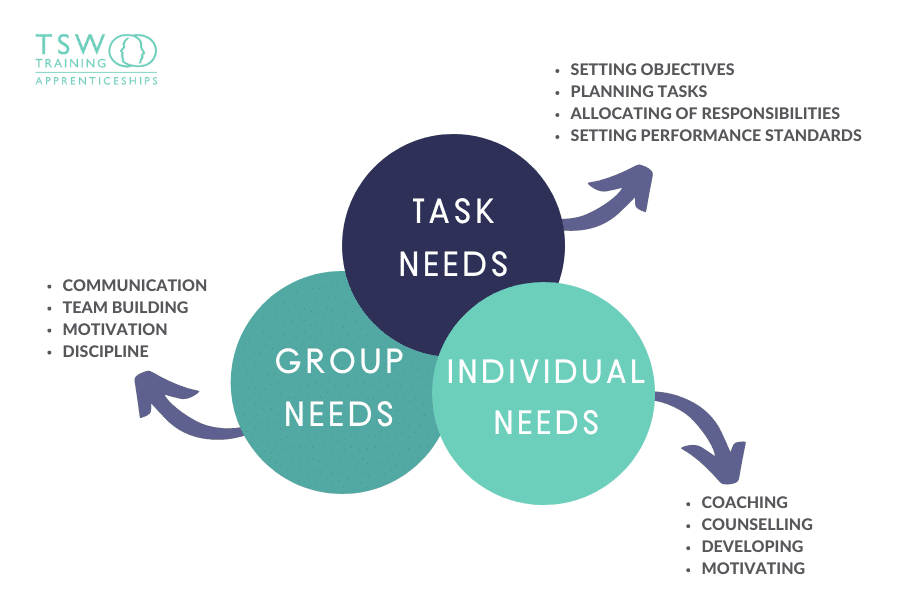It is easy to forget that every successful Fortune 500 company leader had a first day on the job, like every new and aspiring company leader.
Brand new leaders and managers transitioning to new roles might experience uncertainty, doubt and a lack of clarity over what it takes to excel in their new positions. If you’re in this position, you might wonder what practical actions and steps you need to take to excel in your new role.
John Adair’s Action-Centred Leadership model is a unique leadership model that was ground-breaking for its time. The model defines effective leadership by actionable steps, offering aspiring leaders, managers, HR and development managers with a working template for success in new leadership positions.
Who is John Adair?
Before delving into John Adair’s Action Centered Leadership model, let’s shed some light on the person behind the model.
Born in 1934, John Adair is a British academic and expert in leadership theory – but that’s not all.
Adair’s unique mix of knowledge and experience spans across military service, a Masters of Letters from Oxford, professorship and lecturing posts.
Before Adair’s Action Centered Leadership model, the ‘Great Man’ theory (which believed that successful leaders shared similar characteristics) took precedence. Adair’s firm belief in leadership as a taught concept played a significant role in challenging the ‘Great Man’ leadership theory.
His Action Centered Leadership theory clearly differentiates between leadership and management.
It defines leadership in the context of three distinct but overlapping spheres: the individual, the task, and the team.
“…it has been a success because staff retention has remained 100% for almost two years, our performance KPIs have improved, we have developed several efficiencies off the back of staff ideas, and have now put this as an objective in their appraisals with a measurable approach.”
– ILM Level 5 apprentice, Jamie Cullen, discusses the impact of John Adair’s theory
What is John Adair’s Action-Centred Leadership model?
John Adair’s three-tiered model of action-centred leadership was developed in the 1960s to dispel the myth surrounding the concept of ‘born leaders’.
Action-centred leadership relies on the belief that leaders are developed, not born.
It is also based on the foundational concept that leadership skills can be learned and transferred without a natural endowment of the ‘right’ traits.
John Adair’s leadership model puts aspiring leaders in the driving seat, highlighting the key actions required for long-term success in any given leadership role.

The three spheres of John Adair’s Action-Centred Leadership model
Achieve the task
The task is a mission that requires strategic guidance, and a joint effort from all team members as it cannot be accomplished by just one individual.
Below are the steps that the model stipulates for providing strategic guidance:
- Determine the team’s vision, aims, purpose and direction in the context of a well-defined activity (or task).
- Determine key people, resources, tools, processes and systems required to achieve the task.
- Implement a plan to achieve the task with clear and measurable deliverables, timelines, tactics and strategies.
- Define key objectives, responsibilities, and reporting methods by delegating roles.
- Establish standards for time and quality of deliverables with defined reporting parameters.
- Control and prevent threats to defined parameters.
- Follow and maintain the progress and performance of the plan.
- Clearly report on the advancement of the teams’ objectives.
- Review, re-evaluate, modify plans, processes and targets as required.
Build and maintain the team
To keep the team operating efficiently, there is a need to actively promote and retain group cohesiveness ensuring that the group values and prioritises its unity.
Adair’s model for optimising the team engagement and efficiency hinges on an understanding of individual motivations. Here are Adair’s recommended steps for building and maintaining the team:
- Create established standards for the team’s performance and behaviour.
- Establish a team style and culture.
- Monitor and preserve the team’s integrity and focus.
- Anticipate and fix internal group conflicts and disagreements.
- Implement standards for effective communication, internally and externally.
- Evaluate and modify the team’s composition and balance as required.
- Develop a spirit of team-working, cooperation and high morale.
- Increase the collective sense of freedom and authority by promoting maturity and developing capabilities.
- Motivate the team by offering encouragement towards the team’s aims and objectives.
- Develop mutually agreed task-driven leadership roles within the team.
- Identify and fulfill training requirements for the team.
- Provide timely group feedback.
Develop the individual
The need of individuals within any team are made of physical needs (e.g conducive workspace, wages) and psychological needs (e.g a sense of purpose and recognition). Failure to meet the individual needs of team members will disrupt the team’s cohesiveness and impair overall performance. Adair’s recommendations for developing the individual are:
- Appreciate the individuality of team members, recognising individual strengths, personalities, needs, aspirations and concerns
- Support individual team members in their professional development
- Establish appropriate responsibilities and objectives for individuals
- Offer individualised praise and recognition alongside constructive criticism
- Provide opportunities for advancement and additional responsibility where appropriate
- Develop individual strengths and capabilities through training.
- Reward exceptional individual performance
Advantages and disadvantages of John Adair’s Action Centered Leadership
The effectiveness of Adair’s Action Centered Leadership model can be attributed to its highly specific and actionable approach.
The emphasis that this model places on the task, team and the individual, keeps a focus on the key fundamental factors capable of driving the direction of any successful leadership journey.
Using specificity and actionable guidance, the model was able to challenge the existing ‘Great Man’ theory, gaining traction among leaders and managers.
While Adair takes a practical and holistic view towards leadership, some critics consider his hierarchical approach unsuitable for the linear structure that can be typical of modern-day organisations.
This is based on the notion that modernised leadership styles lean towards empowerment and enablement of team innovation, and Adair’s traditional approach may seem authoritarian.
The skills our apprentices learn on a Leadership & Management course can prepare them for almost anything.
Listen to our ILM Level 5 delegate Jamie Davies, talk to us about flexing his leadership muscles in the Jordanian desert, during his time as a recruit on SAS: Who Dares Wins.
Will John Adair’s theory make an impact in the workplace?
Leadership and Management Training Advisor, Sue Hampson, uses John Adair’s Action Centered Leadership model in her ILM apprenticeships.
She says: “We start by comparing Fayol’s five functions of management, which was an early 19th Century management theory. While the principles of the five functions are still relevant, the focus at that time was more on the organisation’s goals than the worker needs.”
“Then we move on to look at Adair. He utilises many of the functions originally outlined by Fayol, but he took a more equal approach to achieve the organisational goal.
“He does this by ensuring that the team, task and individual needs are met, the objective is met, that the task needs are communicated, and the right people have the right tasks assigned to them,” she explains.
“The individuals are motivated to achieve and receive reward or recognition when they do so, but skills must be reviewed and personal development plans in place to ensure team members have all the right skills, competencies and knowledge to achieve the tasks.”
John Adair’s Action Centered Leadership: Work-based case study
Sue’s ILM Level 5 apprentice, Jamie Cullen, applied John Adair’s action centered leadership model in his workplace, at Bridgend Council. He told us about learning to apply it through his apprenticeship and what impact it had…
Since researching the John Adair action centred leadership theory, I have taken a new holistic approach, so that when any form of change is presented, no matter big or small, I look at it in terms of the three elements, ‘task, team and individual’.
If it is a big change required where I need to do a SWOT or brainstorm exercise to establish where change is needed, I will think about the three elements of task team and individual.
For example, under ‘task’ I will establish what the end goal is and create a problem statement, to help me understand what it is I need to do to fulfil the requirements to get there. That can be:
- A review of service in-efficiencies
- A review of technology enhancements or amendments
- The impact changes would have on adjacent tasks
- Getting staff buy-in and so on
Under ‘team’ I look at how we can obtain buy-in and keep the workforce engaged, their need to contribute and add value, and change the culture. I initiated:
- Quarterly sessions to ask for ideas, concerns, solutions and act on their advice to build trust
- Set up a focus group to test new methods, develop knowledge etc
- Reminders to communicate frequently to keep people in the know
- Initiatives to get rewarded and recognised for input, ideas and identifying risks.
Finally, for ‘individual’, we looked at how we monitor performance in line with corporate performance management policies, reviewing all training documents for new services and update existing training materials, feedback regularly and also use Maslow’s theory to understand what motivates each individual. I ask them where they put themselves on the hierarchy of need to manage their expectations.
I often try and see how any change impacts all three areas and how to manage them. Some of these initiatives were already in place during my qualification, but since having learnt the theory, it has helped me change my approach whilst we are still managing ongoing projects.
I’d like to think it has been a success because staff retention has remained 100% for almost two years, our performance KPI’s have improved, we have developed several efficiencies off the back of staff ideas and have now put this as an objective in their appraisals with a measurable approach.
I think we will see an even better output from it when the new technology goes live because it is going to allow for customers to do so much more in terms of self-service which will create even more capacity, which the staff need after a draining couple of years due to Covid.
I have been on a number of management courses through existing and previous employers, but none have really stuck with me as much as this particular theory. It really has helped me broaden my leadership capabilities.
Because of the unpredictable nature of leadership in the real world, there might be a need to adjust your implementation focus to match the demands of your organisation.
For example, a new time-sensitive project might require a primary focus on building a team and achieving a task than developing the team.
Leaders and managers can rely on Adair’s Action Centered Leadership model as a useful blueprint for managing a variety of teams, groups and organisations.
There is, however, a need for leaders to rely on personal judgement when determining appropriate areas to prioritise to suit each unique situation.
Need to develop your Leadership and Management skills?
Here are just some of courses we offer at TSW:
- ILM Level 2 in Leadership and Team Skills
- ILM Level 3 in Leadership and Management
- ILM Level 5 in Leadership and Management
- Core Skills for Management Training Course
- Core Skills for Team Leaders Course
- Management Training Courses
- ILM courses and qualifications
- Leadership and Management Apprenticeships
- and more







